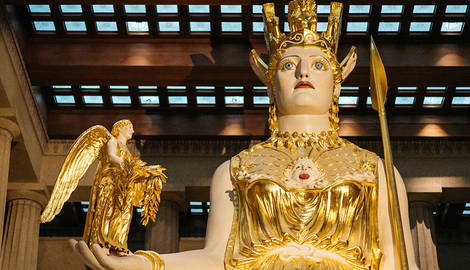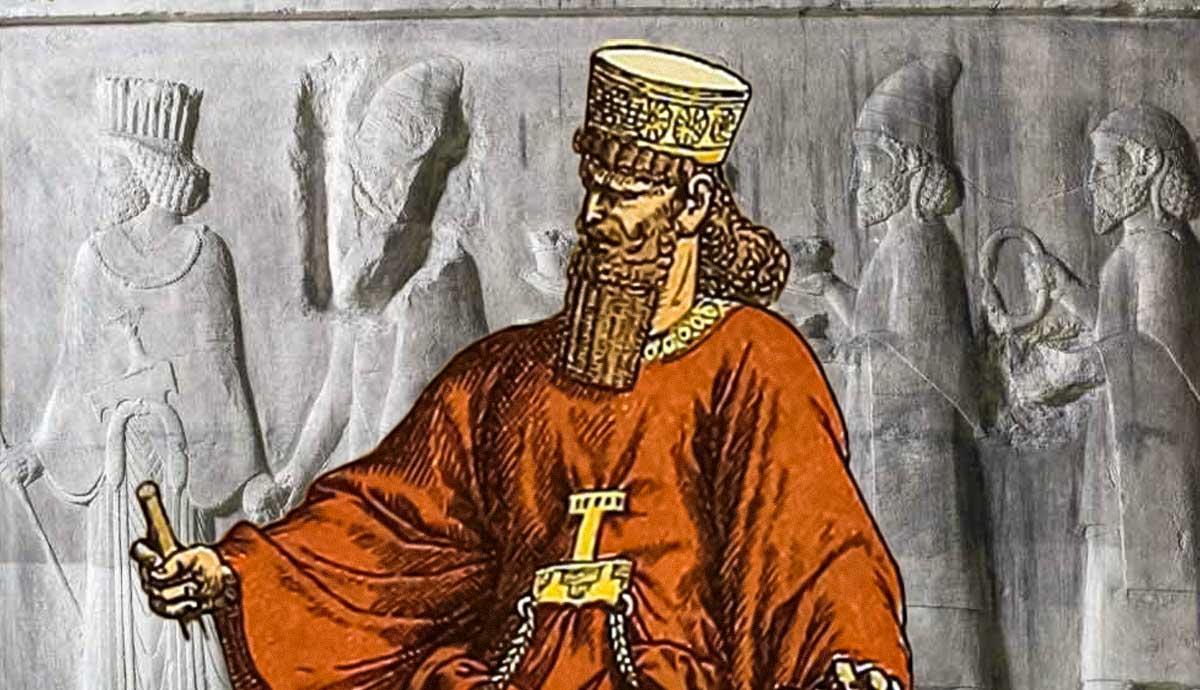
summary
- The Athena Parthenos was a colossal ivory and gold sculpture, symbolizing Athens’ power and the goddess’s wisdom and war-prowess.
- Crafted by Phidias for the Parthenon in Athens in the 340s BCE, it was the temple’s magnificent centerpiece.
- The 40-foot-tall statue is helmeted with a spear and Athena’s famous aegis.
- The fate of the original statue is unknown, but it is known through Roman replicas and ancient descriptions.
The statue of Athena Parthenos was a large-scale ivory and gold statue created in the 5th century BCE and dedicated to the goddess in the Parthenon on the Athenian Acropolis. The larger-than-life devotional image of one of ancient Greece’s most important goddesses was considered a wonder in ancient times. What do we know about the statue, when it was built, what it looked like, and what happened to it?
Who Is Athena Parthenos?

Athena was the Greek goddess of wisdom, war, and handicrafts, and one of the most popular deities worshipped in ancient Greece. She was considered the patron goddess of numerous Greek cities, including Athens.
Zeus impregnated Metis, the goddess of wisdom, but due to a prophecy, became concerned that a son born from Metis would be more powerful than he. Therefore, he tricked the pregnant Metis into transforming into a fly and swallowed her. But Athena continued to grow inside of Zeus, eventually giving him such a terrible headache that he had to ask Hephaestus to break his head open. Athena emerged fully grown and fully dressed in spectacular armor made for her by Metis. She became one of the Olympian gods.
Athena was a complex goddess with many aspects, recognized by various epithets. Athena Parthenos was Athena the Virgin, recognizing that Athena was one of the female Greek gods, alongside Artemis and Hestia, who chose to remain a virgin rather than submit to a man. The title also recognized her role as an enforcer of sexual modesty and other social norms that governed society.
Where Was the Statue of Athena Parthenos Located?

A statue of Athena Parthenos was created to serve as the centerpiece of the Parthenon on the Athenian Acropolis. This temple was dedicated by the people of Athens to their patron goddess.
Construction of the Parthenon had begun in the 480s BCE, but it was destroyed by the Persians. In 447 BCE, under Pericles, the Athenians set out to build the temple again, funded through their domination of the Delian League. It was to serve as both a temple of Athena and the treasury of the league, a common purpose for temples in ancient times.

The Parthenon hosted the annual Panathenaic procession that celebrated the birth of Athena. Her statue stood in the center of the temple on a raised platform, and it was redraped each year as part of the procession. Before her statue was a water basin that maintained the humidity of the building, and also cast a glittering light on the statue when reflecting the sun.
Who Created the Athena Parthenos Statue?

The Greek sculptor Phidias, known for designing the Parthenon and creating the state of Zeus of Olympia, also created Athena Parthenos. While we know little about the life of Phidias, writers such as Plato and Plutarch praised his works, many of which survive as Roman replicas. The statue and the Parthenon were commissioned by the Athenian politician Pericles, who specifically chose Phidias to oversee the program.
What Did the Statue of Athena Parthenos Look Like

The statue of the goddess was grand in size, standing about 40 feet tall. The interior ceiling of the Parthenon stood only 42 feet tall, which meant that the goddess’ statue dominated the space and looked down on worshippers.
The statue is a chryselephantine work, meaning it was made of ivory and gold, both expensive materials that are extremely hard to work with, showing the expertise of the craftsmen. She was not made of solid ivory, which would have been impossible for such a large structure. Instead, its core is made of cypress wood, taken from a wood dedicated to the god Apollo, reserved only for use with religious purposes. It was then covered in thin sheets of pressed ivory. Gold was added as ornamentation, most likely to emphasize certain features such as her helmet, face, and drapery. Stones and gems were inlaid as well, adding to the decoration, as well as casting shadows on hinge spots in the ivory.
What Details Were Depicted on the Athena Parthenos Statue?

Athena was adorned in a peplos dress, not unlike the common depiction of the Peplos Kore in Greek sculpture. Her facial expression was stoic and neutral, with slightly parted lips that may have represented the breath of life. Her eyes were inlaid with gems, giving her a life-like appearance when lit by the sun.
Athena’s helmet, shield, and pedestal all point to important stories about the goddess. Her helmet was of the attic style, decorated with a guardian figure of a sphinx, flanked by victorious winged horses. This iconography emphasized Athena’s part in the triumph of the city during the war. Her shield, or aegis, was a symbol of protection and was decorated with a gorgon’s head. Athena famously helped the hero Perseus slay the gorgon Medusa, and took her head as a prize to scare her enemies.

In her left hand, Athena held a spear while a shield rested in front of it. This shield was decorated with both an Amazonomachy and a Gigantomachy, both elaborate scenes of battles between the gods and monsters. The opposite hand carried a small statue of Nike, the goddess of victory, representing the power of both Athena and her triumphant city. The statue stood on a platform decorated with the story of Pandora, which represents the goddess’s virginal aptitude. Together, the symbols of gorgons, amazons, giants, and women represented Athena’s glory as a feminine warrior and savior.
What Did the Athena Parthenos Statue Symbolize?

Overall, the statue of Athena Parthenos symbolizes war, wisdom, and the glory of Athens. She is meant to portray the goddess as strong, warfaring, and victorious. Placing her in the context of the Parthenon, she was surrounded by Doric columns. This Greek order represents strength and stability, symbolizing the power of Athens after its victory.
Athena’s pose was also willful and commanding, though quite uncommon for sculptural depictions. Her left leg was slightly bent, which was mimicked in the curve of her right arm, yet her weight was not shifted, as in the typical contrapposto stance of Greek statues, seen in works like Polykleitos’s Doryphoros. This attribute is most likely due to her monumental size, as this unbalanced weight would create strain on her large-scale form.
What Happened to the Original Athena Parthenos Statue?

The Parthenon was damaged by a fire during late antiquity, probably sometime in the 3rd century CE. There was serious damage to the building and also the statue, but Athena was restored. However, following the Theodosian Decree of 380 CE that outlawed all pagan temples, the Parthenon was largely abandoned. It was converted to a church sometime between the 5th and 7th centuries CE, but there is no mention of the statue in the structure at that time.
It has been suggested that the statue was still in Athens somewhere and was transported to Constantinople in the 10th century, along with the statue of Zeus of Olympia. Others suggest that it was destroyed by Christian iconoclasts. The fate of the Athena Parthenos is, unfortunately, unknown.
Are There Any Replicas of the Athena Parthenos Statue?

Luckily, many replicas of the Athena Parthenos exist, as the Romans were in the habit of making replicas of Greek sculpture. The Varvakeion Athena is reportedly a faithful reproduction crafted by the Romans in the 3rd century CE. The Lenormant Athena is a 1st-century CE, smaller-scale statuette meant to depict the monumental sculpture, which has allowed scholars to study what the original may have looked like.

Alan LeQuire famously recreated the statue of Athena Parthenos in the 1990s, referencing ancient sources that detailed the statue in her original state. It is located in the copy of the Parthenon located in Nashville, Tennessee.








